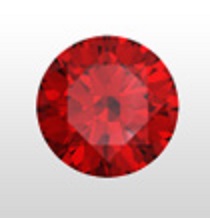Garnet is a Semi Precious Stone Many people believe that garnet is one semi-precious stone, but it actually represents a series of minerals They can be found in all sorts of colors (like orange or green), but people tend to associate garnets with a dark red shade. It is the birthstone of January and is known to be wonderful for those who travel and go on adventures. In addition to this, garnets are connected to empathy, as well as building up self-esteem.

There are many different species of stones within the garnet family. Almandite, demantoid, hessonite, malaya, pyrope, rhodolite, spessartite and tsavorite are all stones in the garnet family tree.

Derivations/Origins: Almandite: Almandite gets its name from an ancient Asian hotbed
of gemstone and fashion trading: the town of Alabanda. This red stone was said to have
lit the course, attached to the bow of Noah's ark after he recognized its inner fire as
a superior light source. Demantoid: Discovered in the Russian Ural Mountains in 1868, this garnet
was marketed by Tiffany and Company as an attractive alternative to the emerald. Hessonite: A close relative of the tsavorite garnet, the hessonite originally
came from Sri Lanka. Malaya: Discovered in 1960s East Africa, the malaya garnet was born
of a chemical mixture of the two garnets, pyrope and spessartite. Its peppy and bright colors
created a small and strong US market in the 1980s. Pyrope: Greeks and Romans valued the pyrope while the Greek word
pyropos means "fiery-eyed" which perfectly describes the lavish red color of this garnet.
This was also a popular stone among Victorian era jewelry. Rhodolite: The two Greek words that impart the name of this garnet:
rhodon ("rose") and lithos (stone) speak to its beautiful color Spessartite: TSpessart, Germany was once a prominent source for this
gem and hence became its namesake. Tsavorite: Discovered in Kenya in the 1970s, Tiffany and Company made
this gem a popular seller in the US market. Color/Style/Uniqueness:
The most familiar member of the garnet family is almandite, bearing a red
or reddish-purple to orangey hue. Demantoid is a garnet with a green to yellowish
green color. It also carries inclusions known as horse tails; wispy and fiberlike,
they branch out from a central point. Often called "cinnamon stone", hessonite has
warm, brownish hues including oranges, yellows and reds. The malaya garnet projects
the perky colors of light to dark pinks, reds and yellowish-orange. The pyrope garnet
is typically a brilliant red but also comes in medium to dark reddish-orange or purplish red.
Actually a mixture of almandite and pyrope, rhodolite is known for its dark purplish-red
or reddish-purple color. Spessartite is a different looking garnet usually found
in a bright orange to dark yellowish or reddish-orange color. Tsavorite is usually
an explosive green or yellowish-green stone, intense in its color. Size/Budget: Care: Almandite Care: Demantoid Care: Hessonite Care: Malaya Care: Pyrope Care: Rhodolite Care: Spessartite Care: Tsavorite Care Final Application:
Demantoid: Rare, the high-quality demantoid has been difficult to find and thus
is a more expensive stone. Supplies in Namibia have recently been uncovered leading
to an increase in its availability.
Hessonite: Less popular than spessartite, hessonite can sometimes be difficult
to find. Hessonite stones over one carat can be on the expensive side.
Malaya: Typically available in a variety of fancy shapes up to ten carats,
the malaya is on the high-end when it comes to expensive garnets.
Pyrope: Pyrope is rarely seen in sizes larger than two carats due
to its limited availability. This makes it a more expensive gem.
Rhodolite: This garnet is widely available in many sizes and is a
best-seller next to almandite.
Spessartite: You should generally be able to locate a round or fancy shape of
this gem up to ten carats. Its vibrant orange color will sometimes lead to higher prices than
garnets of a more common reddish hue.
Tsavorite: Few known sources of this garnet equal limited supplies leading
to a more expensive gem. This stone is generally found in a smaller size, typically maxing out at three carats.
*Never steam clean almandite.
* Never steam clean demantoid
* Never steam clean hessonite.
* Never steam clean malaya.
* Steam cleaning pyrope is risky.
* Never steam clean rhodolite.
* Never steam clean spessartite.
* Never steam clean tsavorite